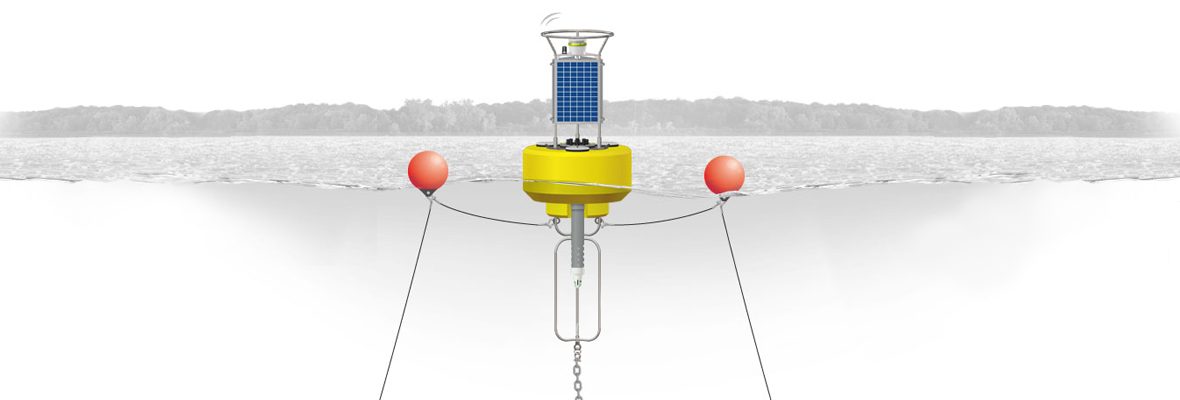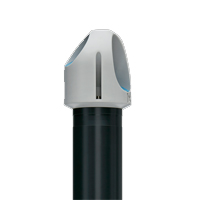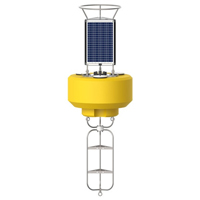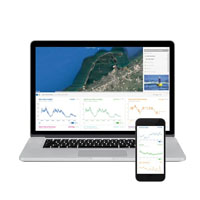Currents are dynamic and sometimes unpredictable, whether they are in tiny streams or the middle of the ocean. Humans have needed to measure currents for ages, but only recently has our technology been up to the task with any real precision. Today, electronic sensors make observations based on underwater acoustics, enabling researchers to measure currents in almost any body of water.
(For a discussion of water flow monitoring, which involves monitoring currents in streams and rivers, please see our water flow monitoring guide. Here, although acoustic technology can be deployed in other ways, we will focus on currents in larger bodies of water such as lakes and oceans.)
Measuring Currents
There are many ways to measure water flow. Different techniques provide varying levels of accuracy, depending on the water’s depth and the elapsed time. A classic method that is still in use in rivers and streams involves a mechanical propeller; tracking how fast it spins over time reveals how quickly the water is flowing.
Today, electronic sensors are available for most applications. For the most basic applications in streams and rivers—that simply need to know the speed of water flow over time—these might not be needed. However, acoustic and electromagnetic meters that judge how quickly current moves over time are now common. These provide more statistical insight into how water flows and respond more quickly to changes in currents.
Instruments based on the acoustic doppler principle, or Acoustic Doppler Current Profilers (ADCPs), are most commonly deployed to measure current.
Acoustic Doppler Current Profilers
Light doesn’t travel very far in water, so it is much more common to use underwater acoustics, which are based on sound, to make observations on currents. Inorganic and organic materials suspended in water prevent light from traveling, scattering it, even in water that seems very clear. However, sound travels a long way underwater and doesn’t lose much fidelity as it goes. This means that sound is an excellent option as a carrier signal for underwater observations.
Acoustic Doppler current profilers use the Doppler effect created by sound waves to measure changes in velocity underwater. They can take these measurements both close to them and further away, and at points in between, several times per second. Specifically, an ADCP works by measuring very high-frequency Doppler shifts between 75- and 600-kHz to reveal a 3D current velocity in an overlying water column.
ADCP Technology
As with any technology that you deploy in water, any ADCP and accompanying instrumentation must be reliable and robust, up to the rigors of long-term use underwater and travel to and from the deployment site. Less-than-reliable technology is always more costly because sensors that fail or provide inaccurate data can be worse than nothing: misleading. Knowing the acoustic Doppler current profiler technologies that are out there can help ensure that you know which systems are best for your application.
Size is important for every application. Smaller sensors should be matched with appropriately sized moorings and mounting structures. The power system must be sufficient for the entire setup, and as low-impact as possible. Most remote sites will rely on solar and battery power, at least in part, and less power consumption means a smaller instrument package that is easier to transport.
The design is just as critical. It is expensive to deploy an instrument package, so maximizing each deployment is essential. Do that by identifying the optimal combination of batteries, cables, mounting frames, and other accessories. Another important tactic is to select an instrument package with software that is simple to configure because that configuration time is a large piece of the deployment day. Ideally, it should be easy to see the instrument on-screen once deployed, and its operation should be consistent.
Most importantly, the wrong equipment is also more likely to fail, get lost, or otherwise, need to be replaced. Measuring currents is expensive, no matter which configuration you choose, but much more so if you have to do it twice. Choose the best possible instrument package for the particular measurement tasks you’re facing to ensure better results. This means selecting the best instrument, with the right features, access to the best acoustic frequencies for the job, and smart mechanical design for easy deployment and lasting battery life.
Selecting the Right Acoustic Doppler Profiler
Many instruments for current measurement are available, depending on your application and use environment. Water currents are typically measured using either a buoy-based acoustic Doppler current profiler or a bottom-mounted ADCP. The bottom-mounted units typically yield better data, but they are more difficult to deploy. Conversely, the buoy-based units are easier to deploy, but the data can be noisier because of the buoy movement (although an integrated compass helps to account for the movement).
As discussed above, the equipment must be reliable and robust, the right size, well-designed, and simply be carefully chosen for the task at hand. Today, the three main players in acoustic Doppler current profilers are SonTek, Teledyne/RDI, and Nortek.
For in-laboratory studies and monitoring in streams, small instruments that accurately capture rapid changes in currents despite a small measurement volume are the right choice. Velocimeters, which typically have one acoustic transmitter and some number of acoustic receivers, are an example of this kind of instrument. Although they are in some ways not much different than the classic mounted propeller, these can measure current accurately despite lots of fast, tiny fluctuations at a smaller scale, such as a stream or river.
In estuaries and lakes, where the scale of water currents is significantly larger, buoy-based systems are typically more useful. They are simpler to deploy and carry internal memory and batteries, enabling them to work autonomously for longer periods of time. The buoys that carry these ADCPs can also carry a range of measurement cells, profiling the entire water column and/or surface waves if desired.
The Acoustic Doppler Current Profiler for Your Water Current Monitoring Project
So much goes into choosing the right instrument package for your water current monitoring project. No one has a bottomless budget or endless time, so each decision in the process matters.
At NexSens, we make it our business to work closely with each client to ensure that they are making sound, evidence-based decisions about their equipment. We have years of experience and an eye on new technologies. To learn more about acoustic Doppler current profilers and water current monitoring, reach out to the NexSens team.
Equipment
The Aquadopp Profiler is a highly versatile Acoustic Doppler Current Profiler (ADCP) includes features used by engineers and researchers to enable accurate and effective hydrodynamic data collection in a variety of environmental conditions.
The NexSens CB-950 Data Buoy is designed for deployment in lakes, rivers, coastal waters, harbors, estuaries and other freshwater or marine environments.
WQData LIVE is a web-based project management service that allows users 24/7 instant access to data collected from remote telemetry systems.





0 comments